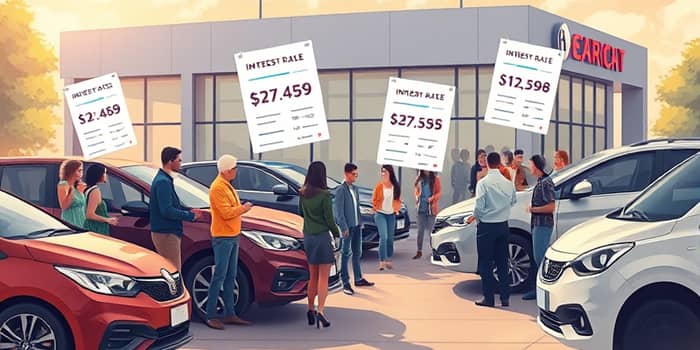
Financing a vehicle is a crucial step that can shape your long-term financial health. In July 2025, auto loan rates and lending options have evolved, offering both opportunities and complex choices for buyers.
Whether you’re shopping for a new SUV or a reliable used sedan, understanding the landscape of interest rates, lender types, loan structures, and negotiation strategies is essential. This guide equips you with expert insights and practical tips to secure the best possible auto financing deal.
Interest rates fluctuate based on market conditions, borrower creditworthiness, and dealer promotions. As of May 2025, the average APR stands at 7.3% for new vehicles and 11% for used models (Edmunds.com). Volume-weighted data from Cox Automotive places new car rates at 9.47% and used car rates at 14.22%, reflecting a competitive yet challenging borrowing environment.
Borrowers with higher credit scores typically enjoy more favorable terms, while those with lower scores incur substantially higher costs. To illustrate this, consider the following breakdown from Experian’s Q1 2025 report:
Auto loans can be sourced from various institutions, each with unique advantages and limitations. Choosing the right lender type can mean the difference between a cost-effective arrangement and an onerous financial burden.
Standout platforms in 2025 include Capital One, Navy Federal Credit Union, PenFed, LightStream, and CarMax. Each caters to different borrower profiles, from pristine credit to more challenging credit scenarios.
Understanding the nuts and bolts of loan terms can save thousands in total costs. Typical term lengths range from 36 to 72 months. While longer terms reduce monthly payments, they also increase total interest paid over the life of the loan.
A larger down payment not only lowers your principal but also diminishes the lender’s risk, potentially unlocking lower interest rates. Be wary of low monthly payment traps offered by excessively long terms.
In July 2025, many automakers are deploying aggressive financing promotions to clear inventory and boost sales of electric and plug-in hybrid models. Select offers include:
0% APR for up to 72 months on certain Jeep plug-in hybrids, subject to inventory; 0.9% for 36 months on Buick Envista; and 2.9% for 60 months on Cadillac Lyriq with cash incentives. Hyundai’s Ioniq 6 and Santa Fe feature 0% financing for up to 60 months through early July.
These specials can dramatically reduce financing costs, but always verify eligibility, model restrictions, and expiry dates before signing.
Securing pre-approval is akin to a credit handshake—it signals to dealers that you’re a serious buyer with a predetermined budget. The process involves a formal credit check and results in a binding commitment outlining loan amount, term, and APR.
In contrast, pre-qualification uses a soft credit inquiry to estimate rates without a firm offer, making it a useful early planning tool but less authoritative during negotiations.
Today’s borrowers have access to sophisticated loan calculators and comparison widgets on lender websites and third-party platforms. By inputting variables—price, term length, down payment, and interest rate—you can model scenarios to determine optimal strategies.
Consider testing the impact of allocating savings from monthly payment reductions toward shorter loan terms. This technique not only shortens debt duration but also minimizes interest costs over time.
Borrowers with scores below 660 face APRs exceeding 20% in some subprime markets. However, specialized lenders and credit unions are increasingly offering tailored products that include:
co-signed loans, secured loan options, and targeted credit-building programs. While rates remain higher, these solutions can help rehabilitate credit profiles when managed responsibly.
Success in auto financing hinges on thorough preparation and strategic negotiation. Key recommendations include:
Shop around for multiple quotes—compare dealer offers with bank, credit union, and online proposals. Always assess the total loan cost, not just the monthly payment. Inquire about fees, prepayment penalties, and required insurance add-ons to avoid surprises at signing.
Additionally, first-time buyers and those considering leasing should weigh mileage limits, end-of-lease charges, and the potential benefits of frequent vehicle upgrades against the desire to build equity.
Armed with current rate data, a clear understanding of lender options, and advanced planning tools, you can confidently navigate auto financing in July 2025. Prioritize obtaining pre-approval, leverage manufacturer specials, and scrutinize loan details to secure an arrangement that aligns with both your driving needs and financial goals.
By following these guidelines, you’ll transform the car-buying journey from a daunting process into an empowering financial decision that drives you toward long-term success.
References













